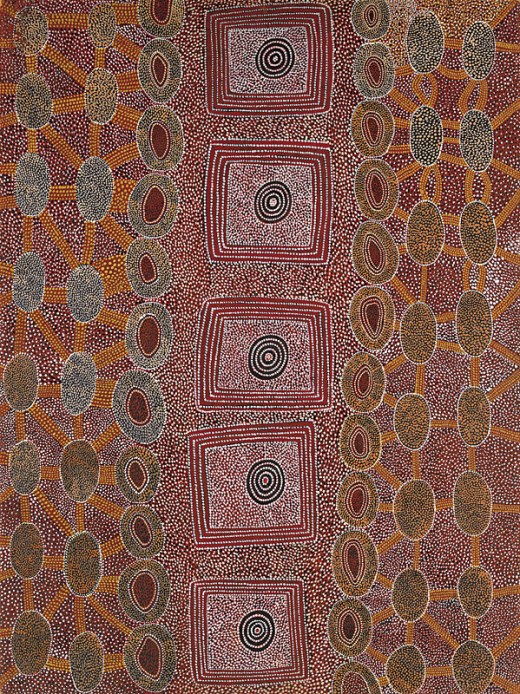Anatjari Tjakamarra, circa 1930-1992, STORY OF A WOMAN'S CAMP AND THE ORIGIN OF DAMPER 1973
Anatjari Tjakamarra, circa 1930-1992, STORY OF A WOMAN'S CAMP AND THE ORIGIN OF DAMPER 1973Estimate $150,000 – $250,000
- Lot Sold $320,000 (Hammer Price)
- $384,000 (Hammer Price with Buyer's Premium)
synthetic polymer powder paint on composition board
bears consignment number A731104 on the reverse
122 BY 92CM
Provenance:
Papunya Tula Artists, Alice Springs
Private collection
Sotheby's, Important Aboriginal Art, Melbourne, 29 June 1998, lot 48
Private collection, UK
Exhibited:
Art of Aboriginal Australia, Rothmans Art Gallery of Stratford, June-September 1974; The Glenbow-Alberta Institute, Alberta, September-October 1974; The Mendel Art Gallery, Saskatchewan, November-December 1974; The Vancouver Centennial Museum, British Columbia, December 1974-January 1975; The Edmonton Art Gallery, January-February 1975; The Art Gallery of Hamilton, Ontario, March 1975; Musee du Quebec, April-May 1975; Musee d'Art Contemporain, Montreal; Dalousie University Art Gallery, Nova Scotia, June-July 1975; Memorial University Art Gallery, Newfoundland, August 1975; Confederation Art Gallery and Museum, September-October 1975; Agnes Etherignton Art Gallery, Ontario, October-November 1975; The Royal Ontario Museum, Ontario, April-May 1976, Literature: R. Edwards, Art of Aboriginal Australia, Canada: Rothmans of Pall Mall Canada, 1974, p.18, pl.6 (illus.).
Cf. For paintings by the artist featuring the concentric square motif, see Possum Men of Yirtjurunya, 1974, collected by Fred Myers, in the collection of the National Museum of Australia, in Vivien Johnson (ed.), Papunya painting, Canberra: National Museum of Australia Press, 2007, pp. 56, 107; Rat Kangaroo Dreaming, 1972, in the collection of the Art Gallery of Western Australia, and Rat Kangaroo Dreaming, c.1974, in the collection of the Museum and Art Gallery of the Northern Territory, in Hetti Perkins and H. Fink (eds.), Papunya Tula: Genesis and Genius, Sydney: Art Gallery of New South Wales in association with Papunya Tula Artists, 2000, pp.22 and 21 respectively, (illus.).
This painting was made as a result of a project carried out by Papunya Tula Artists and commissioned by the Aboriginal Arts Board of the Australian Council. In November 1973, Peter Fannin, the manager of the cooperative, provided each of ten Papunya artists with two composition boards of identical size (122 by 92 cm). These were the largest supports to be given to the artists since the inception of the painting movement at Papunya, and they mark a transition to the introduction of canvas upon which artists could paint on a much larger scale. Eight of the 22 boards were selected by the Aboriginal Arts Board as part of an exhibition, Art of Aboriginal Australia, that toured Canada from June 1974 to May 1976; apart from Anatjari's work, this exhibition included paintings by Long Jack Phillipus Tjakamarra (2 works), Toby Moore Tjangala, John Tjakamara, Kaapa Tjampitjinpa, Shorty Lungarta Tjungurrayi and Uta Uta Tjangala.
The painting refers to the ancestral creation of damper, a cake made from spinifex seeds. The oval forms represent dampers cooking in earth ovens, and the square shaped designs represent the camps of the ancestral Women. The composition is one of more symmetrical that Anatjari painted in the early years of the Papunya painting movement and the graphic elements in the work are part of his personal lexicon of imagery: in Anatjari's paintings the concentric squares usually relate to the Tingari ancestors; the sets of roundels formally arranged and joined by straight lines comprise the matrix of site/place and journey also associated with the Tingari. The contrast between the fields of dotting which describe the background of the painting and those that decorate the geometric shapes produce a vibrant and pulsating picture surface.
This painting is described in the Art of Aboriginal Australia catalogue as: 'an interesting design featuring a legend telling the origin of damper, and Aboriginal 'cake' made of spinifex seeds.
Women of the Western Desert sometimes draw these designs on the ground with a stick, this is called Mani-Mani.
The oval forms represent dampers cooking in earth ovens. The square-shaped designs are the camps of the women in the Dreamtime. The deeper meaning of myths is told only to initiated men' (Edwards, 1974, p.18)
This painting is sold with an accompanying certificate from Papunya Tula Artists.

